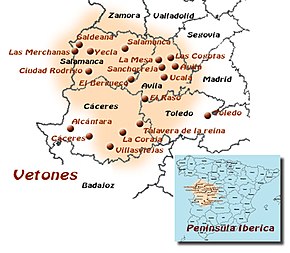Vettons

The Vettones ( Latin Vettones , Greek Οὐέττονες ) were an ancient people präkeltischen origin in the western center of the Iberian Peninsula , which on the high land between the rivers Duero (Durius) and Tajo (Tagus) (now southwestern Castile and Leon and northern Extremadura ) lived.
history
Since the 6th century BC Fortified settlements in the area of the Vettonen can be traced back to the 4th century BC. Developed to oppida . In the Celtiberian War and the Hispanic War , the Vettons stood on the side of their neighbors to the west, the Lusitans who were closely related to them . Around the year 206 BC They shook off the Carthaginian yoke that was temporarily imposed on them , but after a defeat against a Roman army under the leadership of Praetor Marcus Fulvius Nobilior in 193 BC. They came under Roman rule and were integrated into the Roman province of Hispania ulterior . After their division under Augustus they belonged to the province of Lusitania ; in some inscriptions the province was named after the Vettons. Their settlement area was that eastern part of Lusitania, which today does not belong to Portugal, but to Spain.
economy
The Vettonen owned numerous herds (sheep, goats, cattle); possibly they also raised pigs. They are also trusted to masterly work with iron . Pliny the Elder mentioned a medicinal plant found in the settlement area of the Vettonen in the Naturalis historia under the name herba vettonica as a remedy against snake venom.
Art and architecture
The mighty bull and boar figures ( verracos ) in western Spain and northern Portugal are often associated with the vettons. The mighty mountain fortress of Castro de Ulaca , partially hewn out of the rock, with its 3 km long wall near Solosancho in the province of Ávila is also assigned to the tribe of the Vettones. The high forts of Castro de Las Cogotas , Castro de la Mesa de Miranda , Castro del Raso , Castro de los Castillejos and Castro de Yecla la Vieja are less well preserved, but still impressive.
literature
- Ruth Stepper: Vettones. In: The New Pauly (DNP). Volume 12/2, Metzler, Stuttgart 2002, ISBN 3-476-01487-8 , Sp. 152.
- Jesús R. Álvarez-Sanchís: Los Vettones (= Bibliotheca archaeologica Hispana. 1). 2a edición. Real Academia de la Historia, Madrid 2003, ISBN 84-95983-16-8 .
- Arqueología Vettona. La Meseta occidental en la Eded del Hierro. = Zona Arqueológica 12 Alcalá de Henares 2008.






